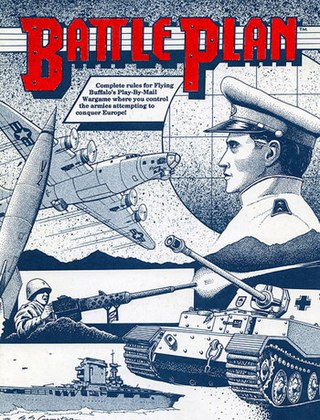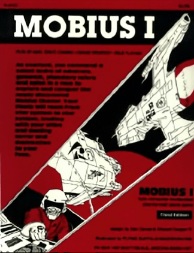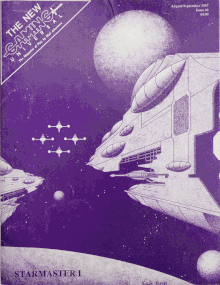
A play-by-mail game is a game played through postal mail, email, or other digital media. Correspondence chess and Go were among the first PBM games. Diplomacy has been played by mail since 1963, introducing a multi-player aspect to PBM games. Flying Buffalo Inc. pioneered the first commercially available PBM game in 1970. A small number of PBM companies followed in the 1970s, with an explosion of hundreds of startup PBM companies in the 1980s at the peak of PBM gaming popularity, many of them small hobby companies—more than 90 percent of which eventually folded. A number of independent PBM magazines also started in the 1980s, including The Nuts & Bolts of PBM, Gaming Universal, Paper Mayhem and Flagship. These magazines eventually went out of print, replaced in the 21st century by the online PBM journal Suspense and Decision.
Starweb is a closed-end, space-based, play-by-mail (PBM) game. First published by Flying Buffalo Inc. in 1975, it was the company's second PBM game after Nuclear Destruction, the game that started the PBM industry in 1970. Players today can choose a postal mail or email format. Fifteen players per game assume one of six available roles and explore and conquer planets within a universe comprising 225 worlds. The object of the game is to attain a predetermined number of points which are generated by various actions during gameplay. Multiple game variants are available. Starweb is still available for play as of 2021 through the company Rick Loomis PBM Games.

Flagship is an independent magazine for gamers that was published from 1983 to 2010. Published bimonthly in the UK, it started in 1983 for play-by-mail game (PBM) players. The magazine also had a United States edition. In 2002, it expanded coverage to encompass other types of games such as boardgames, card games, computer games, and others. Nicky Palmer was the founding editor, with Carol Mulholland assuming editorial duties as of issue No. 70. The magazine ceased publication in 2010 after issue No. 130.
Universe II is a computer-moderated, science fiction, play-by-mail game designed by Jon Clemens and published by Clemens and Associates, Inc. in 1979.

The Nuts & Bolts of PBM was a magazine dedicated to play-by-mail games, first published in June 1980 as Nuts and Bolts of Starweb, and edited by Richard J. Buda. The magazine incorporated in 1983 to Bolt Publications. Rick Loomis of Flying Buffalo Games stated in 1985 that the Nuts & Bolts of PBM was the first PBM magazine not published by a PBM company. He stated that "It was a fun magazine, but somewhat ahead of its time, and it had no financial backing." Afterward, the name changed to Nuts & Bolts of Gaming.

Heroic Fantasy is a computer-moderated, dungeon crawl play-by-mail game. It has been active since 1982 when it was published by Flying Buffalo. The initial edition involved nine dungeon levels. Flying Buffalo published subsequent editions due to challenging gameplay initially, eventually limiting the game to four dungeon levels with a fifth outdoors level where players can assemble an army and capture one or more castles. The game is open-ended; gameplay continues until players decide to stop.

Hyborian War is a play-by-mail game published by Reality Simulations, Inc. It takes place during the Hyborian Age in the world of Conan the Barbarian created by Robert E. Howard. The game has been continuously available for worldwide play since its inception in 1985 and has changed little in its overall format. It uses a computer program to adjudicate player orders. Although it relies on postal mail or email and has turnaround times which are relatively long for the digital age of video games, Hyborian War has remained active into the 21st century.
Midgard is an open-end, medieval fantasy play-by-mail game. It was published in 1984 by Time Space Simulations. Through 1996, the game passed through more than four different publishers, including Midgard USA. As of 2022, Talisman Games is the publisher. At initial publication, Midgard was computer moderated with partial human moderation.
Paper Mayhem is an out-of-print play-by-mail (PBM) game magazine that was published in Ottawa, Illinois. The staff published the initial issue in July 1983 and the magazine ran until mid-1998. Its format was 40 pages published six times per year. The magazine was the most well-known of the play-by-mail periodicals of the period, providing articles and reviews of play-by-mail games, as well as reader-informed ratings of play-by-mail companies, game masters (GMs) and games, both intermittently and on an annual basis. The magazine, along with its long-time editor-in-chief, David Webber, was influential in the play-by-mail community, even echoing into 21st century play-by-mail activities. The publication ceased suddenly in mid-1998 following the unexpected death of Webber.
CTF 2187 is a closed-end, computer-moderated, play-by-mail (PBM) game that was published by Advanced Gaming Enterprises in the 1980s. It involved teams of robots, of varying size and capabilities, battling on a hex-grid arena with the purpose of defeating the opposing team or their command post. Players assumed the role of a battle robot pilot. The game was tactically-focused, with combat action beginning on the first turn. Games lasted 5–10 turns, or about six months. Players began at the rank of cadet but could spend experience points earned from a completed game to increase in rank for future games, up to the rank of General.
Beyond the Stellar Empire is a play-by-email (PBM) game. Originally published by Adventures By Mail, BSE was an open-ended "space opera" with a single available game that began in playtesting in 1981. According to Stephen Marte, during the mid-1980s, like "Tribes of Crane and Midgard, BSE [was] the stomping ground of many of PBM's best power gamers". The game had two variants, one monitored by Game Masters who imposed artificial constraints, and another without constraints. Gameplay took place on a vast space stage where mega-corporations formed the dominant organizing framework, alongside various other groups that players could join to pursue tasks to advance, collaborate with other players, and progress to more senior positions such as space colony governors. Beyond the Stellar Empire placed #5 and #11 for Best PBM Game of the Year in 1987 and 1988, respectively, in Paper Mayhem, a magazine for play-by-mail games. In subsequent years, the game did not score well in Paper Mayhem reader ratings for playability, use, and product understanding. Beyond the Stellar Empire: The New System won the Origins Award for Best New Play-By-Mail Game of 1989.
Lords of the Earth (LOTE) is a play-by-email game, first published by Thomas Harlan in 1983 during a growing era of PBM games. Initially played by postal mail, the game featured mixed moderation—computer moderated with some human assistance. By 2002, the publisher processed turns by email (PBeM). Lords of the Earth comprises multiple campaigns, each one a separate game. Campaign 1 is the oldest, set in the mid-1800s in the "Age of Air and Steam". Other campaigns begin from 2000 BCE to 1400 CE. Settings were global in scale, with one campaign featuring an outer space setting.

Battle Plan is a closed-end, military strategy, play-by-mail (PBM) wargame. It was first published by Flying Buffalo Inc. in 1972, as one of the company's game offerings after Nuclear Destruction, the game that started the PBM industry in 1970. In August 2021, Rick Loomis PBM Games began publishing the game.

Victory! The Battle for Europe is a closed-end, military strategy, play-by-mail (PBM) wargame. The game was first published by Rolling Thunder Games, Inc. in 1991 after a period of initial growth in the PBM industry. The game centers on Europe while including parts of North Africa, the Middle East, the United States, and Canada. Forty players start each game with equal resources among countries, although geography causes differences between starting positions. Games last for about three years each. The game received positive reviews and rankings in the PBM magazine Paper Mayhem in the 1990s, including tying for second place in its Best PBM Game of 1995 list.

Feudal Lords is a closed-end, computer moderated, play-by-mail game set in medieval England. Starting as a game run through a magazine in 1977, it was first published by Graaf Simulations, later run by Flying Buffalo, Inc, and is today published by Rick Loomis PBM Games.

Quest is an open-end, fantasy, play-by-mail (PBM) role-playing game. Initially released in the United Kingdom in 1991, by Adventures by Mail, it later became available for play in the United States, Australia, and other countries in Europe. The game has a First and Second Age, initially comprising about twenty worlds of up to 1,000 parties controlled by players. After the year 2000, the worlds consolidated into four. The current publisher is KJC Games.

Mobius I is a closed-end, space-based play-by-mail (PBM) wargame of space conquest. The game was first published in 1984 by Mobius Games and was subsequently published by Flying Buffalo, Inc. and Rick Loomis PBM Games.
Galaxy: Alpha is a science fiction play-by-mail PBM game available for play by 1984. Bruce Lockhart of Intergalactic Games co-designed the game as an improvement on the PBM game Starmaster by Schubel & Son. A human-moderated, open-ended game of medium to high complexity, the game had a massive gameplay setting. Players focused on expansion by conquest with combat as a central feature. The game received various reviews in gaming magazines of the 1980s, receiving low marks for its poorly written rulebook with high marks for gamemaster support and generally for the game overall.
Crisis is a closed-end, computer moderated, play-by-mail wargame. It was developed and published in the United States by 1981 by Rick Barr. Additional companies later licensed the game in the United Kingdom, including Mystery and Adventure Games and Timepatterns, the latter having sole UK publication rights by 2000. Multiple reviewers found the game similar to the boardgame Risk, while others compared it to the PBM game Nuclear Destruction. About nine players were in each game which last around 8–12 turns. The game setting was 21st century earth with 42 countries, some notional or supranational. Combat, including nuclear missile exchanges, diplomacy, and intrigue were elements of gameplay. It received mixed reviews in various gaming magazines in the 1980s.










